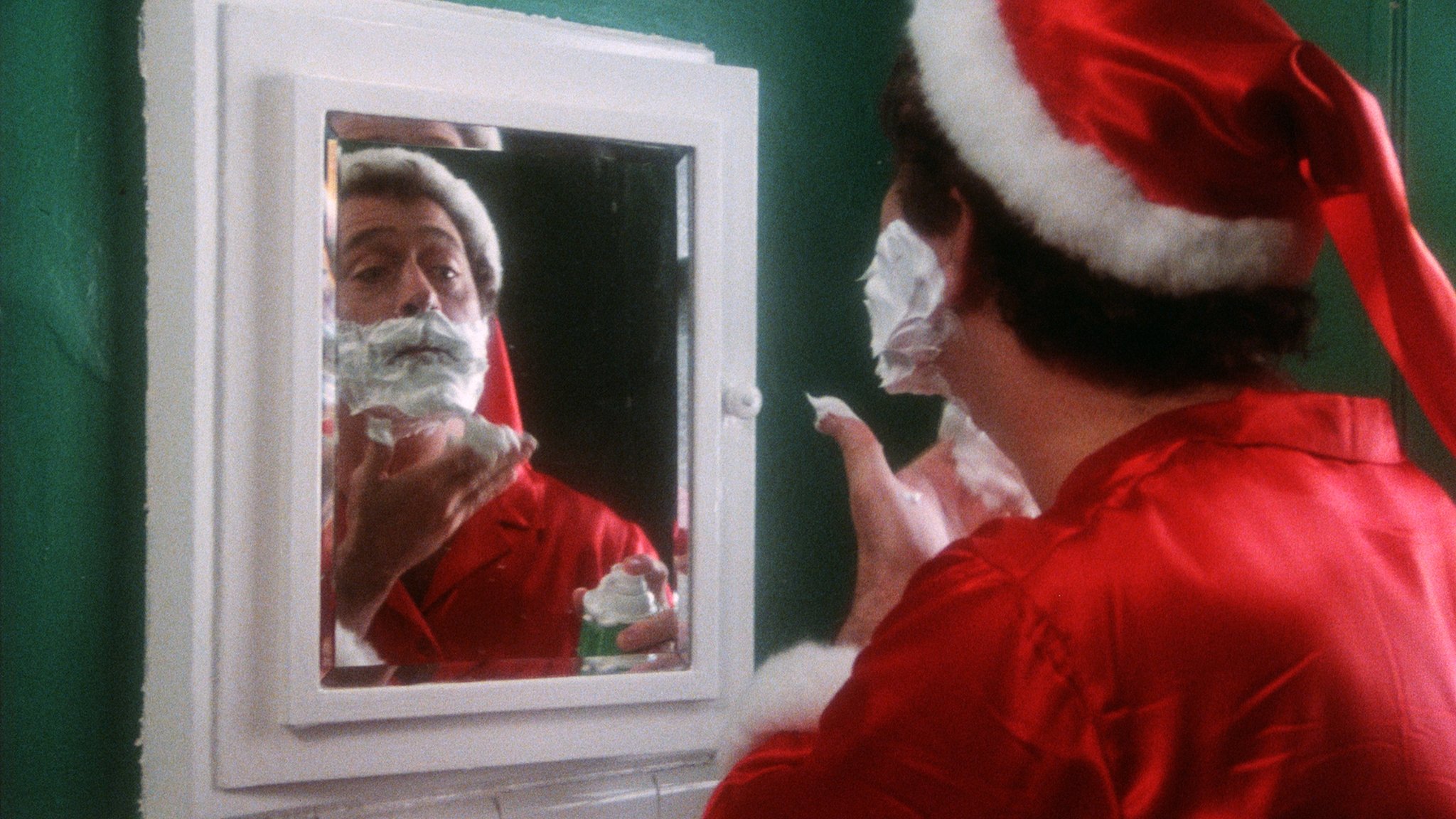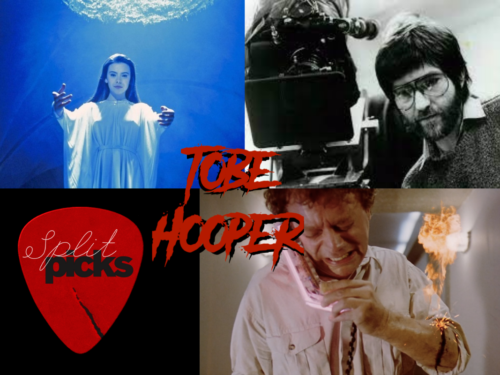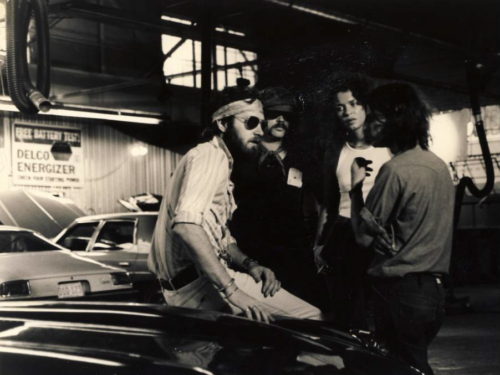Despite its punny title and schlocky premise, Lewis Jackson’s yuletide character study understands the unique blend of sadness and madness that Christmas can bring far better than most respectable takes on the holiday season
It’s apparently a myth that suicide rates spike each year during the holidays. There’s a reason you’ll hear that chestnut again this year as though it were actually true — it sure sounds like it could be. Whether observed from a purely religious or purely secular perspective, there’s something inherently melancholy, even downright depressing, about Christmas. To the faithful, the holiday celebrates the birth of a child who’s fated to die terribly, the promise of salvation that can only come through extreme sacrifice and suffering. Even less devout celebrants can’t help but be reminded of their own advancing age, family members long gone, and the harsh winter months that welcome each new year. Whether or not it immediately suggests Good Friday, Christmas is a yearly reminder that good things don’t last, that memories fade, that everyone dies.
Filmmakers ranging from Frank Capra to Ron Howard appear to agree. Capra’s It’s a Wonderful Life is undoubtedly the most beloved Christmas film of them all and is among the most indelible Christmas stories in any medium. It doesn’t open with carols or bright lights, but with George Bailey (Jimmy Stewart) in the depths of despair, contemplating suicide. His grief is so great, so incongruous with the “holiday spirit,” that it not only inspires prayers from his loved ones, but even attracts the attention of angels. The fact that it all works out in the end can’t change what we’ve experienced, what George has experienced. The film’s bookends — so different in tone — suggest that for every tearful reunion this holiday season there’ll be at least as many lonely hearts. In fact, the film has built that blend of misery and mirth into our understanding of Christmas both on-screen and off. If nothing else, we feel sad around the holidays because we know we’re supposed to.
Howard, for his part, interrupts How the Grinch Stole Christmas’ nauseating antics midstream with a musical number from Cindy Lou Who (Taylor Momsen). Asking, “Where Are You Christmas?”, she alludes to the book’s lightly anti-consumerist message while confirming that even the most garish, cash-grabbing holiday entertainments can’t help but quote Capra. It’s a paradox befitting the holiday season itself, where commerce and sentimentality always go hand-in-hand. It’s apparently a myth that Coca-Cola designed the first white-bearded, rosy-cheeked Santa Claus. That one sounds like it could be true, too.
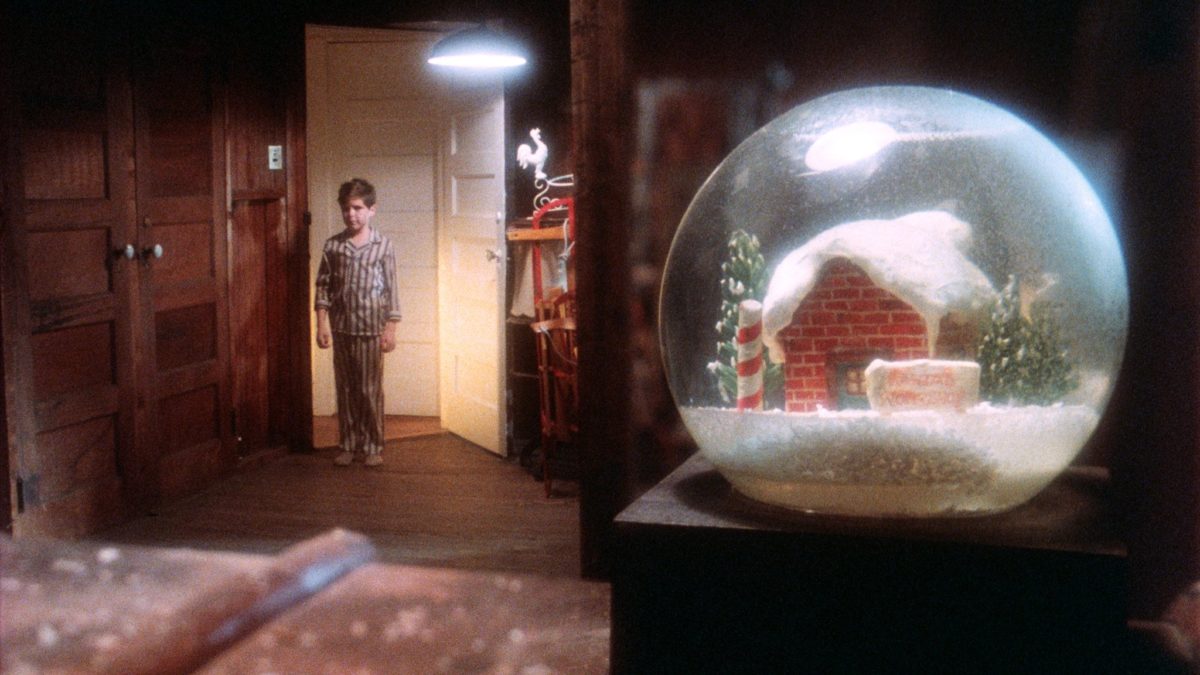
Jim Carrey’s big, green ass aside, the history of melancholy Christmas films is largely a proud one. It’s a Wonderful Life and Meet Me in St. Louis sit atop a list that includes everything from Todd Haynes’ Carol to countless adaptations of A Christmas Carol. At a glance, Christmas Evil may not look a likely entrant in that list. Don’t let the trashy packaging fool you. Its punny title and all-too-familiar premise (another killer Santa Claus?) belie a film that has much more in common with Taxi Driver than with Silent Night, Deadly Night. It’s a grim, darkly comic, and sometimes queasily empathetic character study that communicates both the melancholy and the madness of the holiday season better than just about any more respectable film.
A lot of killer Santas are pure opportunists. For them, the suit, the hat and even the holiday itself are little more than convenient cover. They’re a way to disguise deadly intentions and even occasionally attract sympathy. Christmas Evil’s murderous St. Nick is different; he’s a kind of anti-Grinch, someone driven mad and driven to imitate Santa Claus because of a unique sensitivity to the holiday spirit. The “noise, noise, noise” that interrupts the Grinch’s peace each year provides a constant, welcome soundtrack to Harry’s (Brandon Maggart) life. Christmas isn’t just an incidental setting for director Lewis Jackson either. This is no mere attempt to cash in on the holiday-themed slasher trend. In both its scripting and set dressing, the film communicates the artificial warmth of the holidays and the manic emotions the period tends to engender. It’s no wonder the film is a favorite of John Waters. However jaundiced its look at the holiday season, its iconography and its intense emotional effect, the film never neglects to take these things seriously. More importantly, it takes an unflinching look at the life of somebody who takes them all too seriously.
Related: George Romero’s Martin: Searching The Soul Of An Incel Vampire In 2019
Here’s a holiday fun fact that’s actually true: America’s Santa Claus myth and gift-giving tradition owe a lot to a poem published in the Dec. 23, 1823 edition of the Troy Sentinel. Although the authorship of “A Visit from Saint Nicholas” is disputed, it’s ubiquity and influence could never be. Outdoing even Capra’s film, it is the quintessential secular Christmas text, providing the archetype for a child’s idea of what ought to happen each Christmas Eve. Its opening line, “‘Twas the night before Christmas,” (often mistaken for the poem’s title) welcomes us to Christmas Evil and Christmas Eve, 1947. The narrator doesn’t wrap the words in any irony or otherwise hint that we should expect a dark take on the classic. What follows is — for at least a few minutes — a largely faithful recreation of that poem.
Alongside his mother and brother, wide-eyed, young Harry (Gus Salud) watches from the staircase as Santa slides down the chimney and carries out the Christmas Eve ritual. Already, we can sense an over-the-top reverence for the holiday and everything it brings. Santa buffs his boots and rinses his hands with water from a small bowl before attending to the milk, cookies, and tree. While cleaning off only makes practical sense, Santa’s careful preparations appear as weighty and deliberate as if he were getting ready to carry out a religious rite. Every object is handled and laid out gingerly, every move carefully executed. It’s not just a matter of keeping quiet to avoid detection. It’s like he’s trying to pass an inspection; in a sense, he is. Just across the living room, the rest of the family looks on in wonder. Their stillness creates a tableau that might evoke the warmth of a Norman Rockwell print if not for how waxen they look; they’re more mannequin than painting. It’s our first hint of the uncanny. The next comes when Santa catches Harry’s eye, taps his nose, and disappears up the chimney.
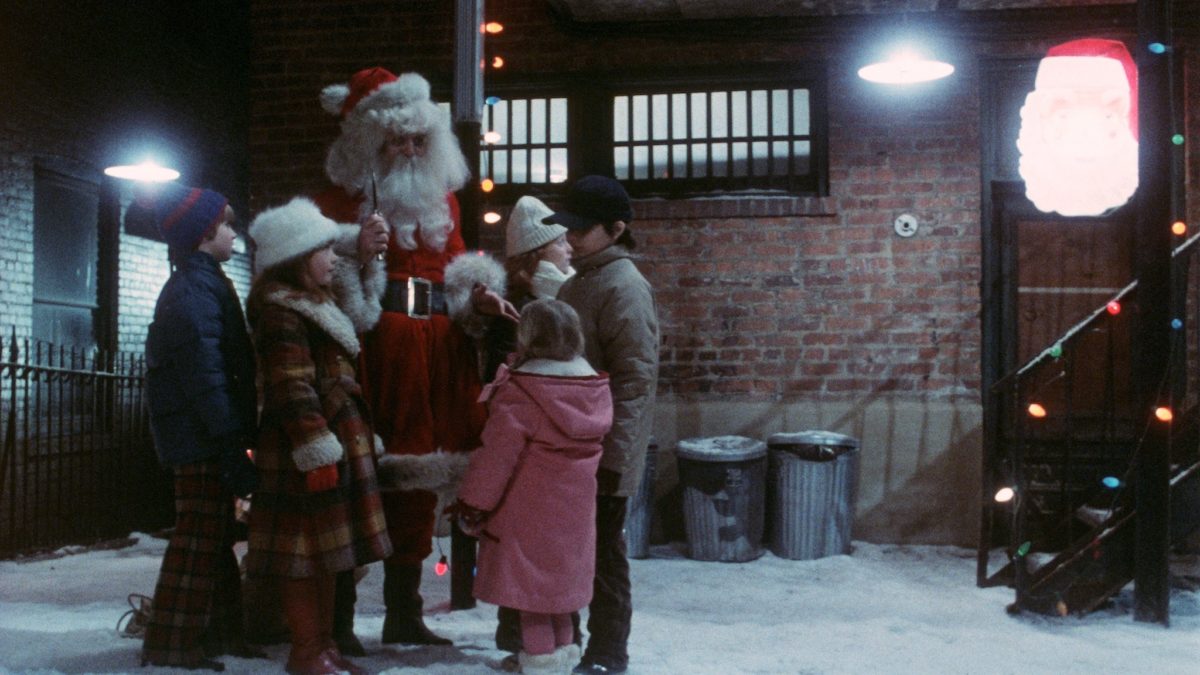
Phil, Harry’s younger brother, disabuses him of the Christmas spirit almost immediately. We don’t see or hear the full exchange, but it’s clear that “Philly” has told Harry the truth about Santa. The disbelieving youngster heads back downstairs to see that mommy and Santa Claus have moved past kissing. It’s just the first instance where the film takes some element of the holiday season — in this case, that awful, awful song — to its depraved extreme. For Harry, the sight is a double loss of innocence. He squeezes a snow globe until it breaks, and his young psyche breaks, too.
More than 20 years later, every day is Christmas for Harry. Rather than shake his holiday spirit, that childhood revelation has imbued him with a conviction that the world needs a Santa Claus. His apartment, at once cluttered and spartan, is a masterpiece of characterization through mise en scene. It’s a bifurcated space, split between a child’s quarters and the lair of a Santa obsessive. Though he wears the familiar red costume to bed, it’s clear that Harry has not yet become Santa in the flesh. Besides an alarm clock blaring “Jingle Bells,” his bedroom is light on holiday paraphernalia and so is at least half of the next room over. When Harry walks out his bedroom to put a holiday record on the turntable, he’s surrounded instead by children’s toys. There aren’t enough for any would-be Santa to distribute and Harry isn’t shown to play with them. As such, they resemble something more like a monument to childhood and the innocence that was taken from Harry. They also serve as silent witnesses to Harry’s elaborate morning routine, a regimen including everything from calisthenics to mock belly laughs. Crossing the living room to the bathroom, he passes several walls of holiday chotchkies, every inch of white paint obscured by Santa’s face. Once he reaches the bathroom, Harry slathers on a shaving cream beard and, for a moment, a childlike sense of joy spreads across his face. As soon as Harry can imagine himself as Santa Claus, however, he’s taken back to Christmas Eve, 1947 and the reminder that there’s no such thing.
The beard isn’t real yet and the painful memories persist, but Harry makes other attempts to play the part of Santa and will the jolly, fat man into existence. In a grotesque approximation of Kris Kringle’s all-seeing eye, Harry spies on neighborhood children and documents their behavior in large, leatherbound volumes. These go back several years and catalogue virtues like “helps with chores” and sins like “bad body hygiene.” He plays the part at work, too. His role at the Jolly Dream toy factory is a calling more than a vocation, an opportunity to make a difference on Christmas and every day. “Don’t you realize,” he shouts during lunch break, “how useful rigidly constructed toys are, how inspirational? They’re valuables well beyond making money.” The argument doesn’t impress his co-workers, and they can’t believe Harry would care more about toys than union meetings and incoming layoffs. Harry’s recent promotion puts even more distance between himself and his peers. He’s in a new managerial role, sitting at a desk rather than piecing together toys. In theory, the responsibilities should suit him. After all, as a manager of other toy makers, he’s more like Santa than ever before.
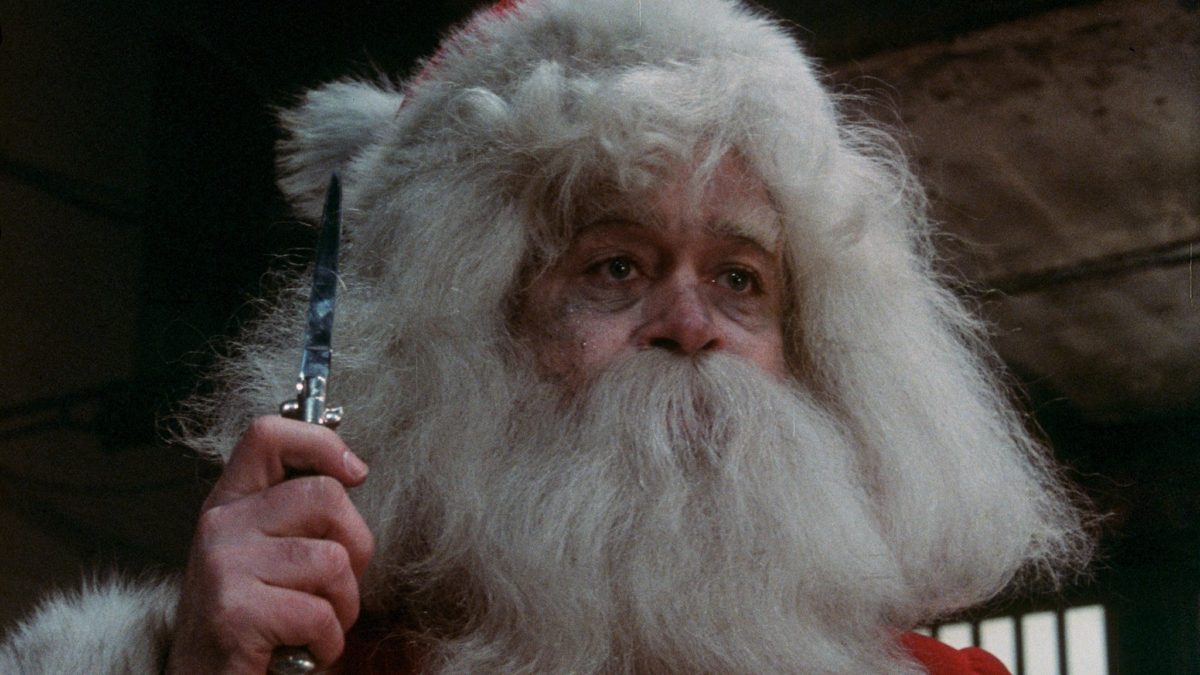
Harry becomes more and more unsettled the more he’s reminded that so-called Christmas spirit is in short supply. Every indiscretion (and his definition is broad) is a fresh reminder that Santa Claus doesn’t exist. Eventually, these reminders only strengthen Harry’s conviction that he ought to make him real. When a coworker (Joe Jamrog) tells Harry, “I hate Christmas the most,” his eyes flash coalblack with hate. That night the same coworker asks Harry to cover his shift, claiming that he and his family are traveling for the holiday. Harry is incensed to see him drinking in a bar later on. This — plus a long look at a couple having sex — send Harry into more flashbacks and a fevered Yuletide fury, redoubling his efforts to become Santa Claus.
Many filmmakers have tried to capture the weeks-long cacophony of the holiday season. Perhaps no one has done it better than Lewis Jackson in his depiction of Harry’s solitary Thanksgiving morning. Rather than join his brother’s (Jeffrey DeMunn) family for dinner, Harry watches a holiday parade on television, waiting, literally at the edge of his seat, for the arrival of Santa. When the sleigh and reindeer finally appear, Harry turns the volume to full blast and stares almost unblinkingly at the screen. The sounds and sights signal the arrival of the holidays. They put Harry into a trance, one that causes his behavior to intensify as Christmas creeps closer. Some weeks later, an office Christmas party (a holiday trauma we can all relate to) finalizes his transformation into Santa Claus. At the party, Harry is reminded that Christmas means more to him than for most. To others, it’s an excuse to get drunk and a valuable opportunity to look the part of the good samaritan. “You’re one of us now,” a superior informs Harry, who looks immediately like he’d rather be anything else. In a sense, the comment ends a lifelong personality crisis. Harry returns home and glues a beard to his face. “It’s me,” he cries, as he tugs on it. “It’s me.”
Come Christmas Eve, Harry is ready to carry out his duties. This is no mere killing spree, but an earnest attempt to reward the nice and punish the naughty — Harry uses the same knife to both open presents and claim victims. Killer Santas rarely bother to do more than look the part. Harry distinguishes himself by taking outsize joy in the jolly side of his job. Outside the Willow Springs Hospital, the sound of jingle bells seem to invigorate him as his belly laughs grow both more manic and convincing. As the night progresses, he inspires as much joy as terror. Stopping into another Christmas celebration, he hands out presents to children and dances with partygoers, looking comfortable in his own skin for the first time. Before leaving, he reminds everyone in attendance of Santa’s twofold role: “I want you to remember to stay good boys and girls… now if you do this, I’ll make sure you get good presents from me every year, but if you’re bad boys and girls, your name goes in the bad boys and girls book and I’ll bring you something horrible.” By imparting this lesson, Harry makes himself a part of the Christmas myth, an annual fixture to be both anticipated and feared. “See you next year,” he shouts on his way out the door.
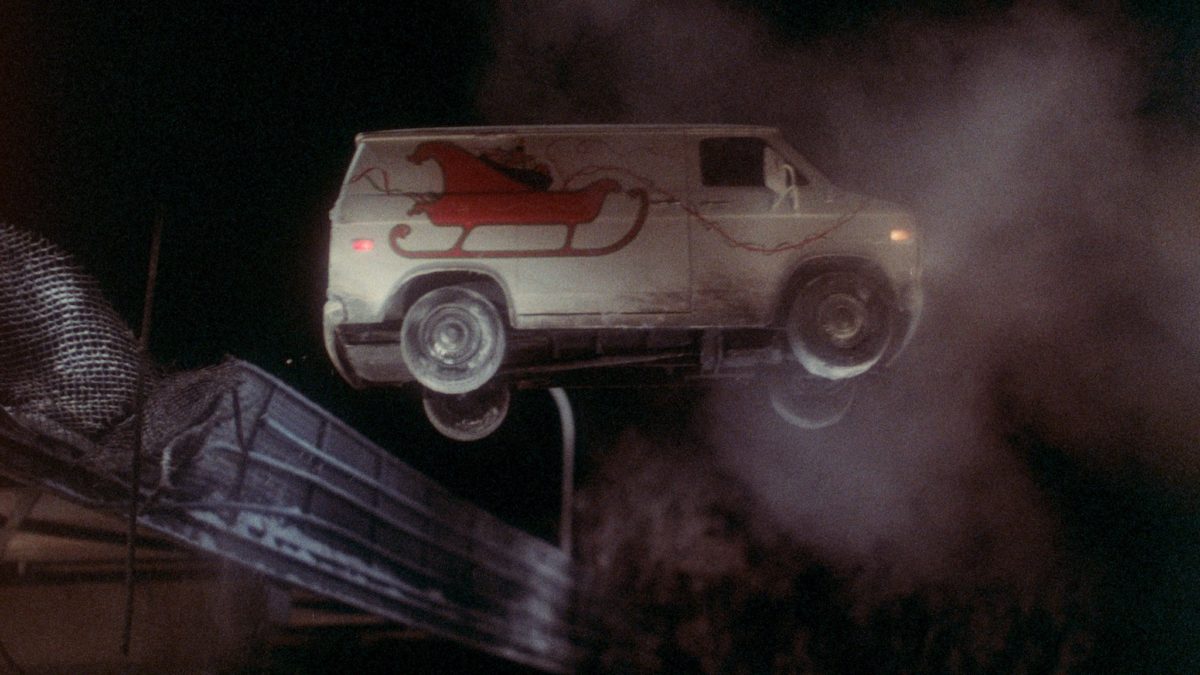
For the most part, the murders are just part of the job for Harry. He doesn’t linger at the scene or luxuriate in the process of his killings. Jackson most definitely does the former. Even after Henry has fled, the film forces viewers to sit in the aftermath of his crimes. On the steps of a church, we listen as a woman screams, “I don’t want to die,” as other onlookers drag her away. We hear the wife of Harry’s lying co-worker wail and watch the screen door slam behind her husband’s killer — their kids have already encountered “Santa” on his way out. In the film’s final moments, we’re even given a chance to linger on Harry’s distraught brother. These marginal sequences give us a brief look outside of Harry’s perspective and force us to reckon with Christmases Yet to Come. Confronted with heaving sobs, widows, and orphaned children we can’t help but think of future Christmases, Christmases where something is missing. Jackson spares Harry this same grim fate. Pursued by assailants with torches and cheered by children, Harry drives his “sleigh” off the road. Taking flight, he enters into both oblivion and immortality as the closing lines of “A Visit from Saint Nicholas” send him off. Like recitations of that poem and presents under the tree, memories of Harry are sure to become an annual tradition for everyone Harry encountered. Harry’s victims and witnesses are certain to follow in his booted footsteps; they’ll pass trauma down like a tradition. Whether future generations dismiss their gory tales as myths, they’ll know the truth. Christmas will never be the same. As Phil puts it, “you’ve wrecked all our lives.”
Purchase Christmas Evil on Blu-ray from Vinegar Syndrome here
Find more October Horror 2020 here:
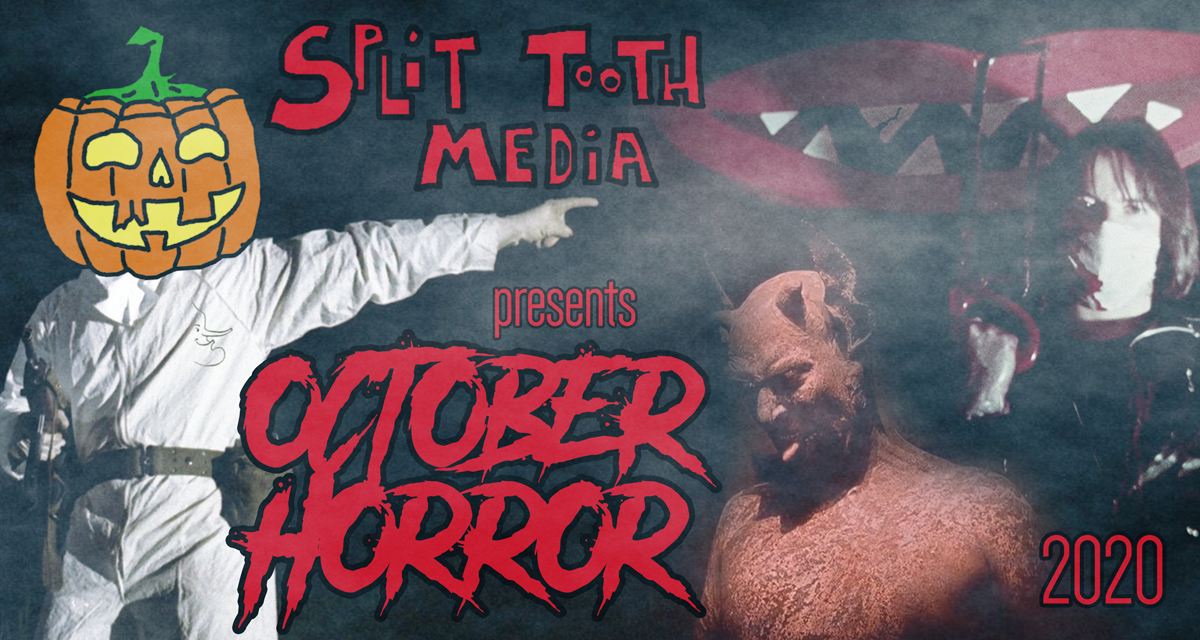
Follow Split Tooth Media to stay up to date with all things October Horror
(Split Tooth may earn a commission from purchases made through affiliate links on our site.)

